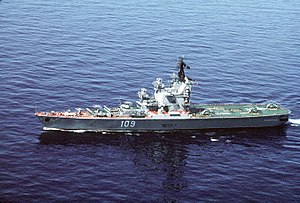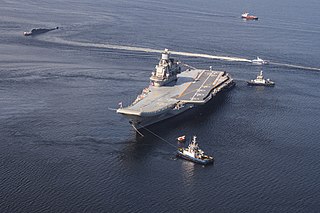
The Kuznetsov-class aircraft carrying cruiser, Soviet designation Project 1143.5, is a class of aircraft carriers operated by the Russian and Chinese navies. Originally designed for the Soviet Navy, the Kuznetsov-class ships use a ski-jump to launch high-performance conventional aircraft in a STOBAR configuration. The design represented a major advance in Soviet fleet aviation over the Kiev-class carriers, which could only launch VSTOL aircraft. The Soviet Union's classification for the class was as a heavy aircraft-carrying cruiser, which permits the ships to transit the Turkish Straits without violating the Montreux Convention. However, the Chinese variants are classified as aircraft carriers.

The Soviet Navy was the naval warfare uniform service branch of the Soviet Armed Forces. Often referred to as the Red Fleet, the Soviet Navy made up a large part of the Soviet Union's strategic planning in the event of a conflict with the opposing superpower, the United States, during the Cold War (1945-1991). The Soviet Navy played a large role during the Cold War, either confronting the North Atlantic Treaty Organization in western Europe or power projection to maintain its sphere of influence in eastern Europe.
The Andrea Doria class were helicopter cruisers of the Italian Navy. Italy's first major new designs of the post–World War II era, these ships were primarily designed for anti-submarine warfare tasks. Initially planned for three ships, the two ships that were constructed, Andrea Doria and Caio Duilio served until 1991 in both active and training capacities. The Andrea Doria class formed the basis for the larger Vittorio Veneto that followed them.

Whiskey-class submarines are a class of diesel-electric attack submarines that the Soviet Union built in the early Cold War period.

The M-11 Shtorm is a Russian naval surface-to-air missile system. Its GRAU designation is 4K60. Its NATO reporting name is SA-N-3 Goblet. The system was first installed on Moskva, an anti-submarine warfare carrier, which was commissioned in 1967, but the system was not officially accepted into service until 1969. Unusually for such systems, it has no land-based counterpart. It was only deployed on Russian vessels, and was never used in combat.

An anti-submarine warfare carrier is a type of small aircraft carrier whose primary role is as the nucleus of an anti-submarine warfare hunter-killer group. This type of ship came into existence during the Cold War as a development of the escort carriers used in the ASW role in the North Atlantic during World War II.

The Kiev class, Soviet designation Project 1143 Krechyet (gyrfalcon), was the first class of both fixed-wing aircraft carriers built in the Soviet Union for the Soviet Navy.

The Kashin class, Soviet designation Project 61, were series of anti-aircraft guided-missile destroyers built for the Soviet Navy since the 1960s. As of 2020, no ships remain in service with the Russian Navy, but three modified ships continue in service with the Indian Navy as Rajput-class destroyers.

Moskva was the first of her class of helicopter carriers in service with the Soviet Navy. Laid down at Nikolayev South, Moskva was launched in 1965 and she was commissioned two years later. Moskva was followed by Leningrad, which was commissioned in late 1968; there were no further vessels built, reportedly due to the poor handling of the ships in rough seas. Both were conventionally powered.

The Kresta I class, Soviet designation Project 1134 Berkut, was a class of guided missile cruiser built in the Soviet Union for the Soviet Navy. The ships were designed for a surface warfare role, but Soviet priorities were changed to an anti-submarine role and only four ships were built in this configuration. They were followed by the Kresta II class, an anti-submarine warfare variant.
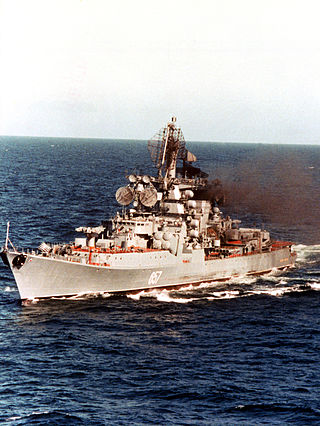
The Kresta II class, Soviet designation Project 1134A Berkut A, was a class of guided missile cruiser built by the Soviet Union for the Soviet Navy. The NATO lists the class as "cruisers" mainly due to the Metel anti-ship missile system capable to strike not only submarines but also surface vessels.
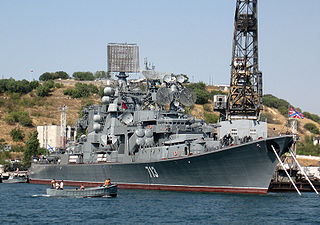
The Kara class, Soviet designation Project 1134B Berkut B, was a class of guided missile cruisers built in the Soviet Union for the Soviet Navy. The NATO lists the class as "cruisers" mainly due to the Metel anti-ship missile system capable of striking not only submarines, but also surface vessels.

Vittorio Veneto was a helicopter cruiser that served with the Italian Navy. Originally intended to be a class of two ships specifically designed for anti-submarine warfare (ASW), only Vittorio Veneto entered into service in 1969, its sister ship Italia being cancelled. Vittorio Veneto was decommissioned in 2003. This ship has the same general layout as the smaller Andrea Doria-class helicopter cruisers, but with two elevators in the flight deck and the hangar below, rather than with the hangar as part of the superstructure. It was named for the decisive Battle of Vittorio Veneto which ended World War I on the Italian front.

Leningrad was the second of two Moskva-class helicopter carriers in service with the Soviet Navy. Laid down at Nikolayev South, Leningrad was commissioned in late 1968. Preceded by Moskva, there were no further vessels built, reportedly due to the poor handling of the ships in rough seas. She was conventionally powered.
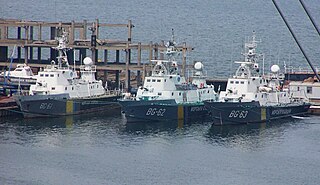
The Stenka class is the NATO reporting name for a class of patrol boats built for the Soviet Navy and Soviet Allies. The Soviet designation was Project 205P Tarantul. The boats are an anti-submarine (ASW) patrol boat version of the Osa-class missile boat.
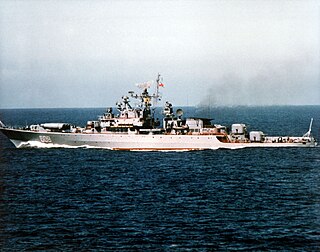
Retivyy was a Project 1135 Burevestnik-class Guard Ship or Krivak-class frigate. With an armament based around the URPK-4 Metel anti-submarine missile system, the vessel served with the Pacific Fleet of the Soviet and Russian Navies. The ship was launched on 14 August 1976 by A.A. Zhdanov in Leningrad, the second of the class built by the shipyard. After joining the fleet, the vessel took part in the search for the crew of the crashed Lockheed P-3 Orion AF 586. In 1981, the vessel sailed as part of a task force along the west coast of the United States to test and measure American defences. Decommissioned on 4 August 1995, the vessel was subsequently sold to a South Korean company to be broken up.

Vasily Chapayev was a Project 1134A Berkut A class cruiser of the Soviet Navy named for Soviet commander Vasily Chapayev. The ninth ship of the class, the vessel was launched in 1974 and served during the Cold War with the Pacific Fleet. Based at Vladivostok, the ship travelled extensively in the Indian and Pacific Oceans, visiting a large number of friendly ports in Angola, Ethiopia, India, Mozambique and Yemen. In 1978 and 1979, the vessel formed part of a flotilla of Soviet vessels including the Project 68bis cruiser Admiral Senyavin that supported Vietnam in the aftermath of the Sino-Vietnamese War. In 1982, Vasily Chapayev was allocated to support the BOR-4 spaceplane programme. 1985 found the vessel undertaking anti-submarine exercises against US Navy submarines demonstrating the Soviet capability of joint operations between aircraft, ships and submarines, which expanded the following year to a dummy attack on the US base at Pearl Harbor. In 1986, the ship took part in the first joint exercises between the Soviet and North Korean Navies. Taken out of active service in 1992, Vasily Chapayev was decommissioned and transferred to be broken up in 1993.

Admiral Isachenkov was a Project 1134A Berkut A large anti-submarine ship of the Soviet Navy. The seventh ship of the class, the vessel was launched in 1972 and served during the Cold War with the Northern Fleet, often operating in the Atlantic Ocean but also travelling to various ports in the Mediterranean Sea. The ship acted as flagship for the Minister of Defence, Marshal of the Soviet Union Andrei Grechko, during the exercise Okean-75 in 1975 and operated alongside the newly launched Project 1143 Krechyet aircraft carrier Kiev in 1977 and 1978. The ship also shadowed the NATO aircraft carriers HMS Ark Royal, USS Independence and USS John F. Kennedy. The cruiser was taken out of service for repairs in 1981 and substantially upgraded with new weapons and communications systems, re-entering service in 1982. With the end of the Cold War, the Navy reassessed its need for large warships and, after a career stretching nearly twenty years, Admiral Isachenkov was decommissioned in 1992 and sold to be broken up.
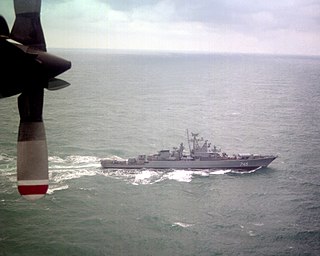
Silnyy or Silny was a Soviet Navy Project 1135 Burevestnik-class Large Anti-Submarine Ship or Krivak-class frigate. Displacing 3,200 tonnes full load, the vessel was built around the Metel anti-submarine missile system. Launched on 29 August 1972, Silnyy served with the Baltic Fleet. The vessel undertook a number of visits to nations friendly to the Soviet Union, including Cape Verde, Cuba, East Germany and Poland. In 1976, while escorting the aircraft carrier Kiev, the ship had a close encounter with the cruiser USS Josephus Daniels, although neither vessel was damaged. Silnyy was taken out of service for repairs in 1990. However, lack of funds meant that, instead, the ship was decommissioned on 30 June 1994 and broken up.
Kiev is the name of several ships:
